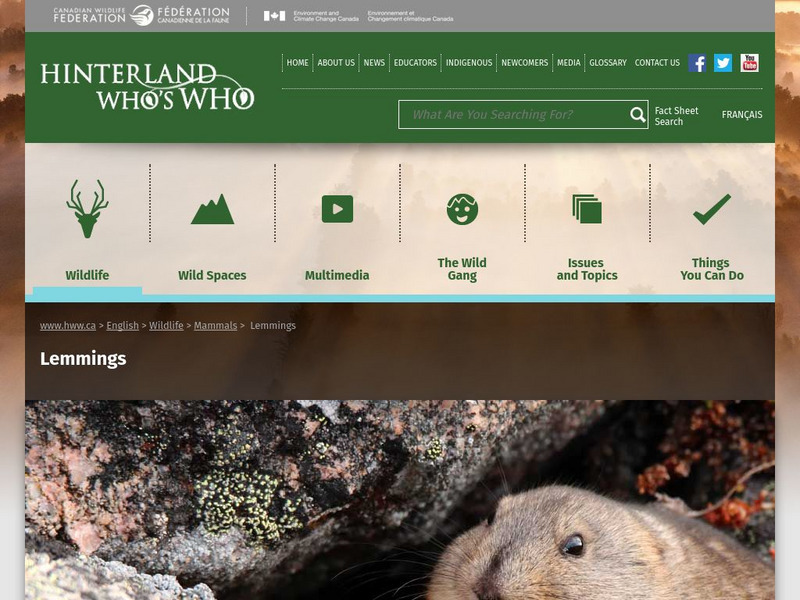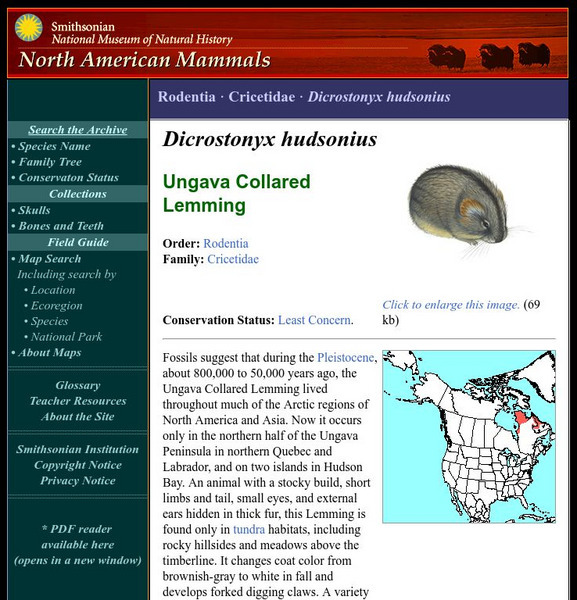Canadian Wildlife Federation
Hinterland Who's Who: Lemmings
Get the facts about lemmings. Besides finding a detailed description of the high Arctic's smallest mammal, you'll also learn about some of its unique facts and characteristics. Also included in this Mammal Fact Sheet on lemmings is...
Regents of the University of Michigan
Animal Diversity Web: Lemmings and Voles
Lemmings and voles belong to the rodent subfamily Arvicolinae. Comprehensive information about these animals is presented, including the positive and negative economic impacts they have on humans. This page has excellent photographs of...
Smithsonian Institution
National Museum of Natural History: Arctic Studies Center: Lemmings
This Smithsonian website has a brief, but thorough, article on the Lemmings that also includes a picture and a quote from naturalist Edward Nelson.
A-Z Animals
A Z Animals: Animal Facts: Lemming (Lemmus Lemmus)
View images and read statistics and facts about Lemmings, including where they live, their appearance, diet, behavior, and breeding habits.
Orpheus Books
Q Files: Rodents
This site provides all kinds of information regarding rodents, small animals with short legs and a tail that can be long or barely visible. The rodent family includes mice, rats and squirrels, as well as beavers, dormice, lemmings and...
Smithsonian Institution
National Museum of Natural History: American Mammals: Brown Lemming
Unlike Norwegian Lemmings, Brown Lemmings do not migrate en masse when they overpopulate their homes in the treeless regions of the north, but they do tend to wander. These are stout-bodied, herbivorous rodents with extremely short...
Smithsonian Institution
National Museum of Natural History: American Mammals: Richardson's Collared Lemming
Richardson's Collared Lemmings are active 24 hours a day. They are found in tundra, and avoid marshy habitats and forested areas. Learn more about the Dicrostonyx richardsoni, more commonly known as a Richardson's Collared Lemming, in...
Smithsonian Institution
National Museum of Natural History: American Mammals: Southern Bog Lemming
Southern Bog Lemmings are born with whiskers and a scattering of hairs on their heads and backs. They are well-furred when they are a week old, and look like miniature adults at two weeks of age. Learn more about the Synaptomys cooperi,...
Smithsonian Institution
National Museum of Natural History: American Mammals: Northern Bog Lemming
Northern Bog Lemmings have a large geographic range, but they are seldom encountered, and the reason for their apparent scarcity is not known. Their preferred foods - sedges and grasses - are abundant, and they do not have very limiting...
Smithsonian Institution
National Museum of Natural History: American Mammals: Ungava Collared Lemming
Fossils suggest that during the Pleistocene, about 800,000 to 50,000 years ago, the Ungava Collared Lemming lived throughout much of the Arctic regions of North America and Asia. Now it occurs only in the northern half of the Ungava...
Smithsonian Institution
National Museum of Natural History: American Mammals: Northern Collared Lemming
Northern Collared Lemmings live farther north than any other rodent, making their homes on the Arctic tundra. They are among the few North American mammals to turn completely white in winter. Learn more about the Dicrostonyx...












